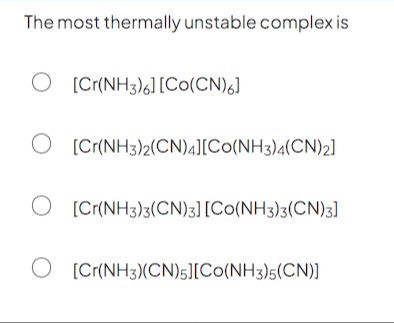Question
Question: The most thermally unstable complex is...
The most thermally unstable complex is

[Cr(NH3)6] [Co(CN)6]
[Cr(NH3)2(CN)4][Co(NH3)4(CN)2]
[Cr(NH3)3(CN)3] [Co(NH3)3(CN)3]
[Cr(NH3)(CN)5] [Co(NH3)5(CN)]
[Cr(NH3)3(CN)3] [Co(NH3)3(CN)3]
Solution
The thermal stability of coordination complexes depends on various factors. When the complex is an ionic compound consisting of complex cation and complex anion, its thermal stability is largely determined by the lattice energy of the crystal lattice formed by these complex ions. Lattice energy is proportional to the product of the charges of the ions and inversely proportional to the distance between them. For large complex ions, the size difference between different complexes may not be as significant as the difference in charges. Therefore, the magnitude of the charges on the complex ions plays a crucial role in determining the lattice energy and thus the thermal stability of the ionic complex salt. Higher the magnitude of charges, higher the lattice energy, and higher the thermal stability.
Let's determine the charges of the complex ions in each option, assuming the common oxidation state of +3 for both Cr and Co.
The general formula for the cation is [Cr(NH3)x(CN)6−x] and for the anion is [Co(NH3)y(CN)6−y].
The charge of the cation is 3+x(0)+(6−x)(−1)=3−(6−x)=x−3.
The charge of the anion is 3+y(0)+(6−y)(−1)=3−(6−y)=y−3.
For the compound to be neutral, the sum of the charges must be zero: (x−3)+(y−3)=0, which means x+y=6. Let's check this condition for each option.
Option 1: [Cr(NH3)6] [Co(CN)6]. Here x=6 and y=0. x+y=6+0=6.
Cation charge: 6−3=+3. Anion charge: 0−3=−3. The compound is [Cr(NH3)6]3+ [Co(CN)6]3−. This is an ionic compound with charges +3 and -3.
Option 2: [Cr(NH3)2(CN)4][Co(NH3)4(CN)2]. Here x=2 and y=4. x+y=2+4=6.
Cation charge: 2−3=−1. Anion charge: 4−3=+1. The compound is [Cr(NH3)2(CN)4]− [Co(NH3)4(CN)2]+. This is an ionic compound with charges -1 and +1.
Option 3: [Cr(NH3)3(CN)3] [Co(NH3)3(CN)3]. Here x=3 and y=3. x+y=3+3=6.
Cation charge: 3−3=0. Anion charge: 3−3=0. The compound consists of neutral complexes [Cr(NH3)3(CN)3] and [Co(NH3)3(CN)3]. This is a molecular compound, not an ionic salt.
Option 4: [Cr(NH3)(CN)5] [Co(NH3)5(CN)]. Here x=1 and y=5. x+y=1+5=6.
Cation charge: 1−3=−2. Anion charge: 5−3=+2. The compound is [Cr(NH3)(CN)5]−2 [Co(NH3)5(CN)]+2. This is an ionic compound with charges -2 and +2.
Now let's compare the thermal stability.
Option 3 is a molecular compound held together by relatively weak intermolecular forces (like van der Waals forces, dipole-dipole interactions).
Options 1, 2, and 4 are ionic compounds held together by strong electrostatic forces in the crystal lattice.
Ionic compounds generally have much higher melting and boiling points and are more thermally stable than molecular compounds due to the strong lattice energy. Therefore, the molecular compound (Option 3) is expected to be less stable than the ionic compounds.
Among the ionic compounds, the thermal stability increases with the magnitude of the charges on the ions.
Option 1: charges +3 and -3. Product of magnitudes = ∣(+3)×(−3)∣=9.
Option 2: charges +1 and -1. Product of magnitudes = ∣(+1)×(−1)∣=1.
Option 4: charges +2 and -2. Product of magnitudes = ∣(+2)×(−2)∣=4.
The lattice energy is proportional to the product of charges. So, the order of lattice energy is Option 1 > Option 4 > Option 2. This implies the order of thermal stability for the ionic compounds is Option 1 > Option 4 > Option 2.
Comparing the ionic compounds with the molecular compound, the thermal stability of the molecular compound (Option 3) is expected to be significantly lower than that of the ionic compounds.
Thus, the overall order of thermal stability is approximately:
Option 1 > Option 4 > Option 2 >> Option 3.
The most thermally unstable complex is the one with the lowest thermal stability, which is Option 3.
